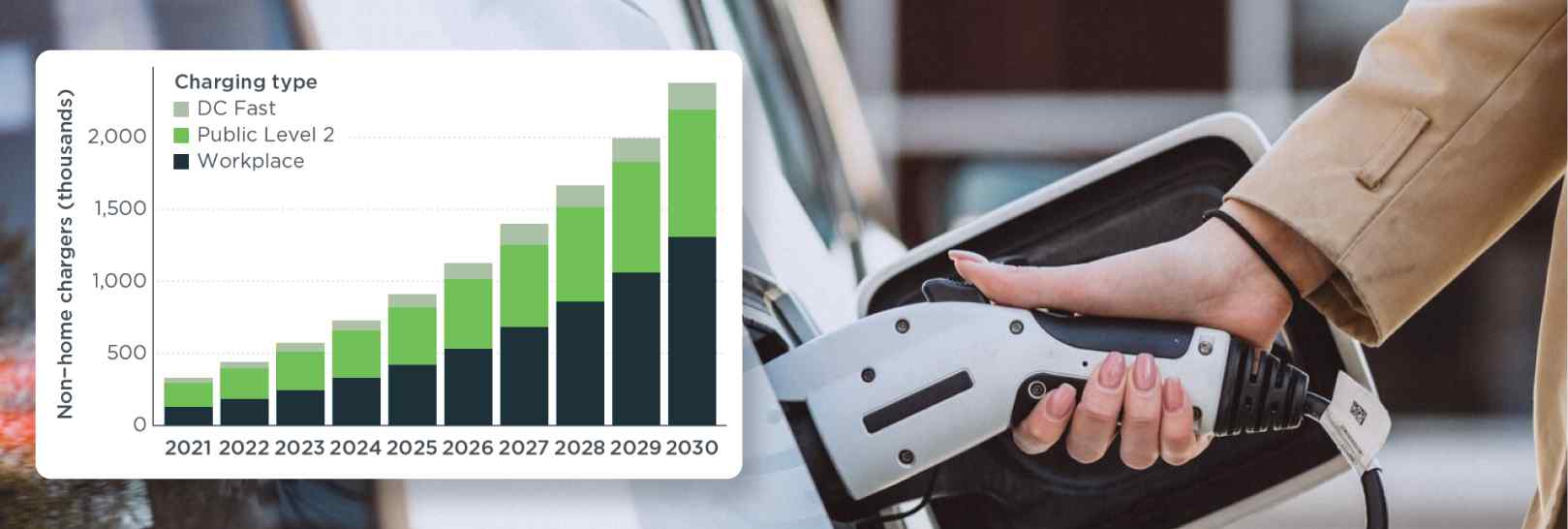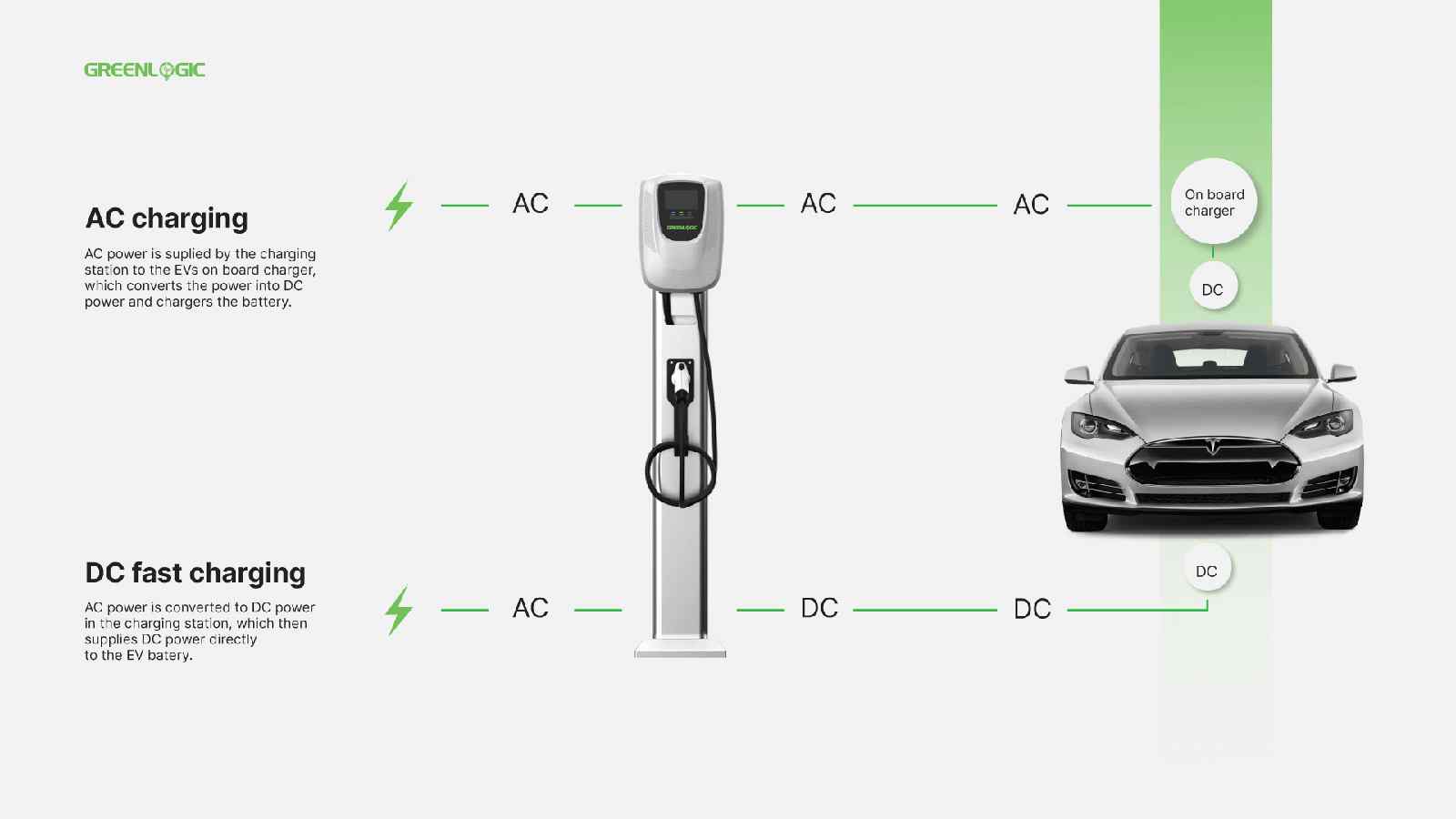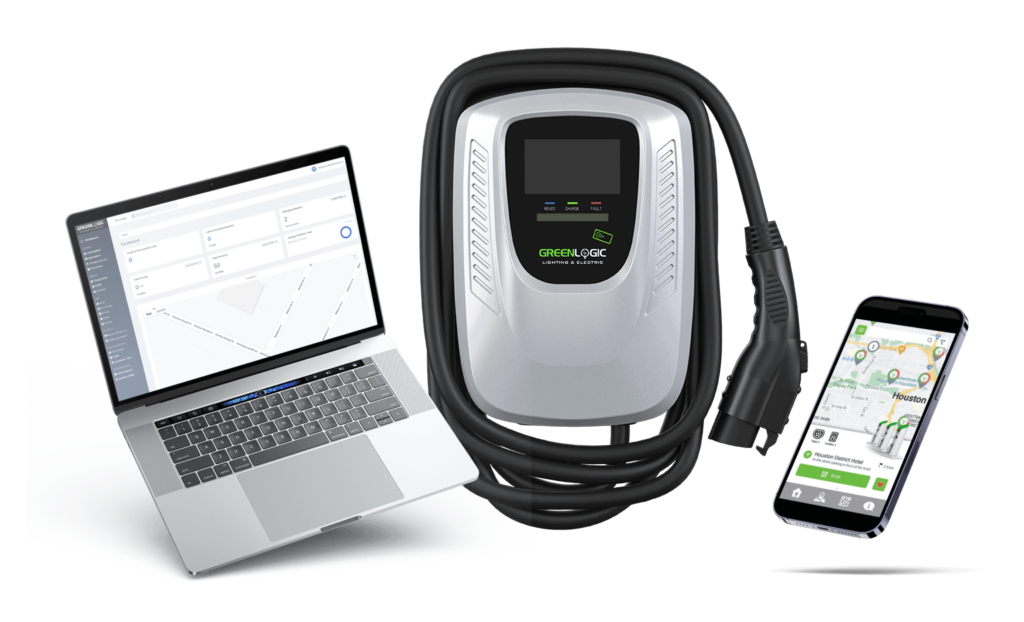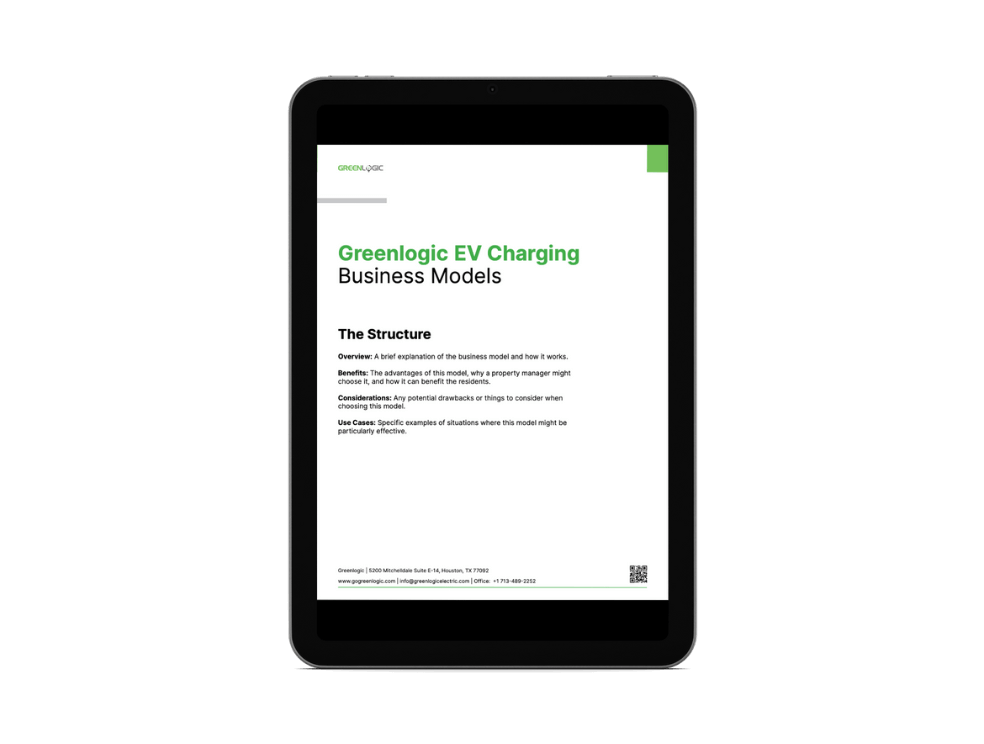


Greenlogic at the 2023 Dayrise Leadership Conference and Paragon Awards

Greenlogic at the HAA Dinerstein Golf Tournament 2023

Greenlogic at the Grateful Americans Charity Gala
Table of Contents
I. Introduction
The electric vehicle revolution is well underway, and with it comes a unique opportunity for forward-thinking entrepreneurs. The adoption of electric vehicles is surging, driving an ever-growing demand for accessible and efficient charging solutions. If you’re considering a business venture that aligns with both economic promise and environmental sustainability, investing in EV charging stations is a strategic move.

In this comprehensive guide, we delve into the intricacies of establishing your own EV Charging Station Business, focusing on the key aspects of costs, purchase considerations, and profit margins. Our mission is to equip you with the knowledge and insights to navigate this exciting and evolving industry successfully.
II. Understanding EV Charging Stations
The Basics of EV Charging Stations
A charging station, also known as an EV charger or electric vehicle supply equipment (EVSE), is a device that supplies electric energy to charge EVs. These stations come in various types and charging levels to cater to the different needs of EV owners. Charging stations can vary in terms of charging speed, with options ranging from standard Level 2 chargers to high-speed DC fast chargers.

For more in-depth insights into the world of EV charging stations, explore our comprehensive guide: The Ultimate EV Charging Guide For Electric Vehicle Owners.
Cost Factors for Charging Stations
When it comes to the costs of EV charging stations, several factors come into play. The primary cost consideration is the purchase and installation of the charger itself. There is a range of charging station models available, with varying features and prices. Factors such as charging capacity, networking capabilities, and durability can influence the cost of a charging station.
Additionally, installation costs must be considered. If you plan to install an EV charger at home, you may need to invest in electrical upgrades or obtain a permit, which could add to the overall cost. On the other hand, installing a commercial EV charging station could involve more extensive electrical work, parking lot modifications, and potentially higher infrastructure costs.
For example:
- Scenario A – Home Charging: Let’s explore a real-life situation where you want to install a Level 2 charging station at your home. After some research, you find a charging station with critical features that fit into your budget of $500. Pre-installation inspection reveals that your home’s old electrical panel isn’t equipped to handle the charger’s load, requiring an upgrade at an extra cost of $1,000. Another factor often overlooked is the cost of local government permits to install an EV charger at home, which can range anywhere from $50 to $500 depending on your location. So, despite the initial charging station cost being only $500, you spend around $1,500 to $2,000 to get your home EV charging station up and running.
- Scenario B – Commercial Charging: Planning to set up a commercial EV charging station in a bustling area, you opt for a more advanced charging station with multiple ports and high networking capabilities, setting you back by $5,000. However, establishing a commercial station involves a lot more than residential installations. For instance, you might need to make parking lot modifications to accommodate the charger, signpost the charging spot, and ensure ADA compliance, all of which can add significant costs. The lion’s share of your expenditure might be dedicated to electrical work and infrastructure improvements, which could amount to $10,000. So, even with an initial hardware cost of $5,000, the total investment could soar to the ballpark of $15,000.
These examples demonstrate that while the cost of purchasing a charging station is a significant factor, it’s just the tip of the iceberg. Whether installing an EV charger at home or setting up a commercial EV charging station, the total cost can be significantly higher when accounting for all necessary modifications and requirements.
Streamlining the Process with an All-in-One Solution
While the prospect of investing in EV charging stations is undeniably enticing, the reality often involves navigating a web of intricacies. Imagine dealing with one hardware manufacturer, another for software, different installers, separate crews for concrete and construction on the site, and a multitude of third-party dependencies. It’s not uncommon to find yourself in a situation where you’re unsure about who to contact if something isn’t working with the charger or how to coordinate various components effectively.

In the face of these challenges, there’s a beacon of hope: the Greenlogic all-in-one solution. Greenlogic offers a true turn-key EV charging solution, providing everything you need under one roof. From top-notch hardware and software to installation, electrical work, and construction, Greenlogic simplifies the entire process. You won’t have to juggle multiple service providers or worry about compatibility issues. It’s a hassle-free way to enter the world of EV charging stations. To learn more about this all-in-one solution, visit Greenlogic’s EV Charging Solutions.
III. Investing in EV Charging Stations
Why Consider the EV Charging Station Business?
The electric vehicle (EV) market is booming with a growing number of consumers switching from traditional gasoline vehicles to EVs. This transition is driving a substantial demand for EV charging stations. Investing in the EV charging station business offers a lucrative opportunity to capitalize on this rising demand, ensuring a steady revenue stream as the market continues to expand.
Furthermore, the push for greener and more sustainable transportation solutions by governments globally creates a favorable environment for EV charging station businesses. Incentives like tax credits, grants, and subsidies are often provided to encourage the development of EV charging infrastructure.
Moreover, by investing in EV charging stations, you position yourself at the forefront of a rapidly evolving industry with immense growth potential. It’s not just about meeting the current demand for EV charging solutions, but also about preparing for a future where electric mobility is the norm.
How to Invest in Charging Stations

Investing in charging stations is an enticing prospect, but understanding the steps involved is crucial to a successful venture. Here’s a clear roadmap on how to get started:
1. Market Research: Begin with thorough market research. Identify areas with high EV adoption rates, such as cities, business districts, or transportation hubs. These are prime locations for charging stations.
2. Type of Charging Station: Decide on the type of charging station you want to invest in. Options range from Level 2 chargers to fast DC chargers. Consider factors like charging speed and versatility.
3. Business Model: Choose a suitable business model. You can opt for a pay-per-use model, subscription-based charging, or even free charging with revenue from ads or partnerships. The choice depends on your target market and location.
Explore Various EV Charging Business Models with Greenlogic
Dive deep into the different pricing models you can adopt for your EV charging station with our comprehensive guide. This document, filled with real-life examples and numbers, provides a clearer understanding of how to set your pricing for EV drivers. Available for free download on our resources page. Get your copy now and make an informed decision for your charging station business!

4. Location, Location, Location: The success of your charging station greatly depends on its location. Secure prime spots with high visibility and accessibility to attract more EV owners.
5. Financial Planning: Prepare a comprehensive financial plan. Calculate all costs involved, including hardware, installation, electrical upgrades, permits, and ongoing maintenance. Assess potential revenue streams and create a budget.
6. Legal and Regulatory Compliance: Be aware of local regulations and permits required for charging station installations. Ensure that your business complies with all legal requirements.
7. Hardware and Software Providers: Choose reliable hardware and software providers for your charging stations. This decision can significantly impact station reliability and user experience.
8. Installation: Work with experienced electricians for installation. Ensure that the station is correctly set up to avoid operational issues.
9. Marketing and Promotion: Develop a marketing strategy to attract EV owners to your station. This may include signage, online promotion, and partnerships with EV-related businesses.
10. User Experience: Focus on user experience. Make the charging process seamless and user-friendly. Consider app-based payments, clear instructions, and 24/7 support.
11. Monitoring and Maintenance: Implement a monitoring system to ensure station uptime. Regular maintenance and updates are crucial for reliable service.
12. Network Integration: Consider network integration with other charging stations to expand your reach and offer more value to users.
Investing in charging stations requires careful planning and execution. By following these steps and making informed decisions, you can establish a successful and profitable charging station business.
Profitability of the EV Charging Station Business
The heart of profitability in the EV charging business lies in the delicate balance between capital investment, operational costs, and revenue generation. Capital investment encompasses the purchase of charging stations and installation costs, which depend on the site’s complexity. Operational costs include electricity, maintenance, and networking, if applicable.
The profitability of EV charging stations can vary greatly based on numerous factors such as the location, the pricing structure, the type of charging station (fast charging vs. standard charging), and operational costs. Here’s a breakdown of the various aspects impacting profitability, along with some specific figures:
1. Profit Margins:
Profit margins for Level 2 charging stations can vary based on factors such as location, pricing structure, operational costs, and utilization. On average, these businesses can aim for profit margins ranging from 15% to 35% depending on the aforementioned variables. It’s important to regularly calculate this metric to ensure your business stays profitable. Remember, low margins may not necessarily be a red flag, especially if the station is new or if there’s a strategic long-term gain in the guise of increased EV adoption or customer loyalty.
2. Charging Rates:
Charging rates for Level 2 stations typically range from $0.10 to $0.30 per kWh. Assuming an average rate of $0.20 per kWh, a Level 2 station could generate substantial revenue.
3. Location and Utilization:
Profitability depends significantly on the location. In high-traffic areas, Level 2 stations often have a utilization rate of 20-40%. Let’s use an estimate of 40% for calculations (which suggests that for 40% of the time, the charging station is being used).
Example Profitability Calculation:
A Greenlogic Level 2 charger delivers 11.5 kWh per hour for a typical EV. So, if we assume a charging session lasts about 4 hours, it would deliver about 46 kWh per session. The calculation is as follows:
Annual revenue = Charging sessions per day × Days per year × kWh per session × Rate per kWh
Assuming:
- Charging sessions per day: 2.5 (equals to approx. 40% charger utilization per day)
- Days per year: 365
- kWh per session: 46 kWh
- Rate per kWh: $0.20
Annual revenue = 2.5*365*46*0.20 = $8,395.00
So, with these assumptions, the annual revenue would be approximately $8,395 for 1 single port EV charger. This demonstrates good revenue potential from a Greenlogic Level 2 charging station, especially in high-traffic areas and with a higher utilization rate, and even more so with multiple EV charging stations.
4. Operational Costs:
Operational costs include electricity expenses, maintenance and repairs, and any fees associated with network service providers. These can amount to approximately 20-30% of the revenue, depending on the specifics of the business and location.
5. Government Incentives and Subsidies:
In some regions, government incentives can significantly improve profitability. For example, a charging station business might receive a grant or tax credits covering a portion of installation costs.
6. Partnerships:
Partnering with local businesses or utility companies for advertising on charging stations or providing charging services to utility companies’ fleet vehicles can create additional revenue streams.
In summary, Level 2 charging stations can potentially generate around $8,395 in annual revenue in a high-traffic area. However, operational costs and factors like location, utilization rate, and any available incentives will significantly impact profit margins. Careful consideration of these elements and possibly forming strategic partnerships can lead to a more profitable EV charging station business.
IV. A Guide to Buying an EV Charging Station
When purchasing an EV charging station, there are a few important factors to consider. Understanding these factors and following a step-by-step procedure can help you make an informed decision and negotiate your purchase effectively.
How to Purchase a Charging Station
There are two primary ways to acquire an EV charging station: direct purchase and leasing.
- Direct Purchase: You can buy a charging station directly from a manufacturer or a reputable distributor. This option allows you to choose from a range of models, features, and price points based on your specific needs.
- Leasing: If you prefer not to make a large upfront investment, leasing a charging station might be a suitable option. Leasing involves paying a monthly fee instead of purchasing the station outright.
Factors to Consider When Buying a Charging Station
Before making your purchase, consider the following factors to ensure you select the right charging station for your requirements:
- Charging Capacity: Determine the desired charging speed and capacity based on your target audience and their charging preferences. Consider the average dwell time of your customers and their expectations regarding charging speed.
- Compatibility: Ensure that the charging station you choose is compatible with the EV models commonly used in your area. Different EVs have varying charging connector types (such as CHAdeMO, CCS, or Tesla Supercharger), so it’s crucial to verify compatibility to serve a broader customer base.
- Networking Capabilities: Decide whether you want your charging station to be networked. Networked stations offer benefits such as remote monitoring, payment processing, and user authentication. Keep in mind that networking features may come with subscription or transaction fees. To explore a reliable and intuitive solution for managing networked EV chargers, check out Greenlogic’s EV Charging Management Software.
- Durability and Weather Resistance: Select a charging station that is built to withstand outdoor conditions. Look for features like weatherproofing, sturdy construction, and resistance to vandalism. Considering the local climate and environmental factors will help you choose a charger that can withstand various conditions.
- Warranty and Support: Check the warranty offered by the manufacturer or distributor, and installer. A reliable warranty and responsive customer support are crucial to address any potential issues that may arise during the lifespan of the charging station.
Procedure to Buy a Charging Station
To purchase a charging station, follow these steps:
- Research: Conduct thorough research to identify reputable manufacturers and distributors. Read customer reviews and gather information about the different charging station models available in the market. Look for certifications and quality standards to ensure that you are purchasing a reliable and safe charging station.
- Determine Your Requirements: Assess your specific needs and consider factors such as the charging capacity, number of charging ports, networking capabilities, and durability. This will help you narrow down your options and choose a charging station that aligns with your business goals.
- Get Quotes: Reach out to multiple manufacturers or distributors to get quotes for the charging station models that meet your requirements. Compare pricing, features, warranties, and any additional services offered to make an informed decision.
- Evaluate Installation Requirements: Consider the installation requirements for the charging station, including electrical upgrades, permits, and any necessary infrastructure modifications. Factor in these costs when making your decision.
- Check for Incentives and Rebates: Research local, state, and federal incentives or rebates that might be available for installing EV charging stations. These incentives can help offset some of the costs associated with purchasing and installing the charging station.
- Consider Support Services: Inquire about after-sales support, maintenance, and repair services offered by the manufacturer or distributor. Having reliable support services in place can ensure smooth operation and minimize downtime.
- Make the Purchase: Once you have compared quotes, evaluated installation requirements, and considered support services, make your final decision and proceed with the purchase. Ensure that you understand the terms and conditions, warranty coverage, and any ongoing fees or payments associated with the charging station.
In conclusion, when buying an EV charging station, research reputable manufacturers or distributors, consider your specific requirements, gather quotes, evaluate installation requirements, and check for available incentives. By following these steps and considering these factors, you can make an informed decision and secure the right charging station for your needs.
Elevate Your EV Charging Venture with Greenlogic
As you venture into the electric vehicle charging domain, aligning with a reliable and experienced partner is paramount. Greenlogic is your go-to platform for top-notch EV charging stations and comprehensive charging services. Our tailored solutions are designed to seamlessly integrate with your unique requirements, providing an unrivaled blend of quality, convenience, and innovation.
Our EV charging solutions stand out in a crowded market, delivering robust performance, user-friendly interfaces, and cutting-edge technology.
Here are some compelling reasons why partnering with Greenlogic will turbocharge your EV charging venture:
- All-Inclusive Solutions: From high-grade hardware and intuitive software to professional installation and ongoing support, we provide a true turn-key solution, removing the hurdles from your path.
- Customizable Options: Our charging stations are customizable to meet the distinct needs of your location and clientele, ensuring a perfect fit for your venture.
- Unmatched Expertise: With years of industry experience, our team of experts is ready to guide you through every step of your EV charging journey, ensuring a smooth and successful rollout.
- Innovative Technology: Stay ahead of the curve with our advanced charging technology that delivers fast, reliable, and convenient charging experiences for EV users.
- Sustainable Impact: Align your business with the global shift towards sustainable transportation. Our solutions not only drive profitability but contribute to a greener planet.
- Reliable Support: Our dedicated support team is always on standby to address your queries, troubleshoot issues, and ensure your charging stations operate at peak performance.
Every journey towards sustainable transportation is a journey towards a cleaner, greener future. Let Greenlogic be the catalyst in your EV charging venture.
Take the next step towards electrifying success. Explore our EV Charging Solutions or contact us today for a personalized consultation. Your electric future awaits!
V. Installation of EV Charging Stations
The installation of EV charging stations involves several variables that can influence the overall cost and process. Whether you are installing a charger at home or setting up a commercial charging station, it’s crucial to understand the involved costs and steps. With a comprehensive understanding, you can plan effectively and ensure the successful installation of your charging station.
Understanding the Installation Costs: Home vs Commercial
The cost of installing EV charging stations can vary significantly based on whether they are intended for home or commercial use.
For home installation, the costs include the price of the charging unit itself and the labor cost to install it. This cost is somewhat predictable and usually ranges anywhere from $500 to $2,000, including labor (depending on the type and brand of the charging unit).
Commercial installation, however, can often be more complex and costly. In addition to the hardware and labor costs, commercial installations may also involve site preparation, upgrades to the electrical service, compliance with ADA and local regulations, and possible networking fees. This can bring the total cost of setting up a commercial EV charging station to anywhere between $3,000 and $7,500 per port, or possibly higher if extensive electrical work is required.
The Process of Installing an EV Charger at Home

Installing an EV charger at home generally involves the following steps:
- Site Assessment: An electrician will evaluate the electrical capacity of your home and the location where you plan to install the charger.
- Permits and Regulations: You may need to obtain a permit from a local government body. It’s important to understand and comply with any local regulations or installation guidelines in your area.
- Installation: A licensed electrician will install the EV charging unit. This process typically involves mounting the charging unit to a wall or pedestal, running the cable to the electrical panel, and setting up the electrical connection.
- Inspection: After the installation, an inspector may need to verify that the work is up to code.
- Activation and Testing: Finally, you will activate the EV charging station and test it with your vehicle to ensure it works correctly.
Setting Up a Commercial EV Charging Station
For commercial installations, the process generally involves these steps:
- Site Assessment: An electrician or an EV charging provider will evaluate the commercial location to determine the feasibility of installation. This involves assessing the site’s electrical capacity, parking area, and any need for construction or pavement work.
- Permits and Regulations: Similar to a home charger, you will need to obtain local permits and ensure you adhere to any local guidelines or laws. Depending on the scale of the project, you may need to consider zoning ordinances, environmental compliance, and ADA regulations.
- Installation Plan: You’ll need to develop an installation plan, which should outline any required electrical upgrades, construction work, locations of the chargers, and a timeline for the project.
- Installation: Commercial charging stations will need to be installed by a licensed electrician experienced in commercial EV charging installations. This stage will involve setting up the electrical connections, mounting the charging units, and performing any necessary site modifications or installations like signage or lighting.
- Inspection and Commissioning: After the installation, it’s typically necessary to have an inspection to ensure that the work meets all building codes and safety standards. Upon a successful inspection, your system will be commissioned, and it can begin operating.
- Network Setup and Testing: If your chargers are networked, you’ll need to set up and test the networking features, like payment processing and remote monitoring. Your charging provider will usually help with this process.
- Training and Maintenance: Your staff should be trained on how the system operates, how to handle basic troubleshooting, and how to use the management software if your system is networked. Regular maintenance should also be scheduled to ensure long-term operation.
Establishing an effective process and understanding the costs of installing EV charging stations are critical steps toward your successful investment in the EV charging business. Both home and commercial installations require proper planning, adherence to regulations, and expert execution.
Greenlogic EV Charger Installation Process
At Greenlogic, we aim to provide a comprehensive and seamless EV charger installation process tailored for businesses. The process encompasses:
1. Pre-Installation Setup
Initial setup of chargers to ensure a smooth installation process.
2. Charger Installation
Expert technicians handle the installation, adhering to local regulations and standards.
3. Preboarding
Preparation for the onboarding session. Providing a business model plan for the chargers.
4. Comprehensive Onboarding
A scheduled session for feature walkthroughs and account setup based on your specifications.
5. Post-Onboarding Support
Provision of a user-friendly guide for effortless account management.
6. Proactive Ongoing Maintenance
Proactive monitoring of all installed stations, addressing any issues immediately for a smooth experience.
VII. Conclusion
Investing in an EV charging station presents a lucrative opportunity, especially with the escalating shift towards electric mobility. However, success in this venture requires a well-rounded understanding of the involved costs, operational considerations, and emerging trends in the EV charging infrastructure domain.
Key Takeaways for An EV Charging Station Investment:
- Research and due diligence are critical for making informed decisions.
- Compliance with local regulations and standards is paramount.
- Networking and partnership with experienced providers like Greenlogic can significantly ease the setup and operational process.
Future Prospects of the EV Charging Station Industry:
The EV charging station industry is poised for robust growth with governments and corporations globally championing for a transition to cleaner, electric transportation. Advancements in charging technology, favorable policies, and growing consumer adoption of electric vehicles are factors propelling this industry forward. Partnering with seasoned players like Greenlogic not only provides a springboard for entering this promising sector but also equips investors with the necessary tools and insights for sustained success.
